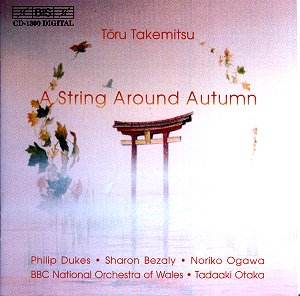The music of Takemitsu successfully bridged the cultures
and philosophies of east and west, and few composers of our time created
music of such fascination and colour. The majority of his large output
of compositions were related to natural phenomena in one way or another,
often by referring to the sounds of nature that inform our living environment.
The most important influences on Takemitsu's musical
language were Debussy and Webern, Messiaen and Cage. Almost all his
music was conventionally scored, and he showed a preference for using
individual instruments in solo or obbligato roles. Beauty of sound and
tranquillity of mood were also particular features of his art, and for
the newcomer this beautifully engineered CD therefore offers an excellent
introduction.
I hear the water dreaming was commissioned by
the American flautist Paula Robinson, who gave the first performance
in April 1987. This is another example of Takemitsu's interest in creating
beautiful, mobile evocations of the natural world. From the beginning,
the flute weaves filigree lines against the shifting background of the
colourful, pointillist orchestral fabric. Although the orchestral contribution
is restrained in both dynamic and texture, the instrumentation calls
for a large ensemble, including three percussionists, two harps and
celesta, which is most effectively balanced in the recorded perspective.
These points might readily be made of the remaining
performances, though there are subtle changes in perspective and colour
brought about by the particular orchestral-solo combinations. For example
Riverrun features the solo piano of Noriko Ogawa, one of the
finest pianists of the younger generation, who is closely associated
with Takemitsu's piano music. Like the string orchestra piece, A
Way a Lone, this is associated with Joyce's ‘Finnegan's Wake’, and
in his carefully researched notes Leif Hasselgren makes appropriate
observations about the relationship between the two artists.
Given the contrasted sounds of piano and orchestra,
it is no surprise that Riverrun is the most conventionally concertante
of these pieces. The solo viola in A String Around Autumn, very
well played by Philipl Dukes, blends more naturally with its surroundings,
of course, just as Takemitsu intended that it should. At nearly 18 minutes
this is the longest of the four pieces offered here. The performance
seems perfectly judged, but that might be said of the others also. For
having worked with this orchestra for many years, Otaka has developed
the kind of close relationship with his players that allows music as
subtle and under-stated as this to make its own point in its own way.
That is no easy task of course. Moreover it is somehow reassuring that
in so ephemeral and vulgar a society as ours, music such as this still
holds evident value.
Terry Barfoot
